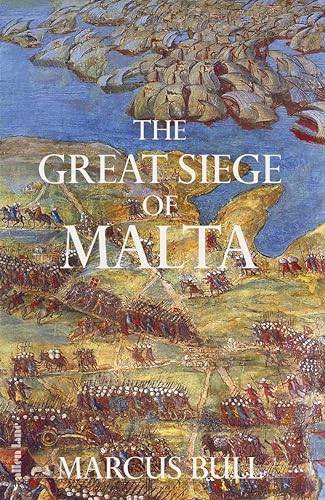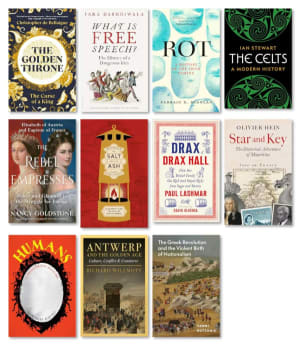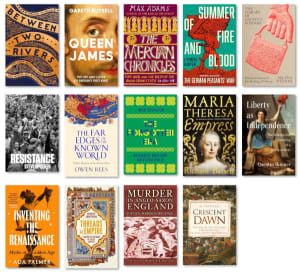If you really want to offend a Knight of the Order of St John I would recommend the ‘alapa’. This seems to have been an open handed slap (presumably to the face) and is described by Marcus Bull in The Great Siege of Malta as a “cool, semi-ritualized performance of aristocratic disdain”.
In a world where violence was common, the alapa was a way of humiliating your opponent as not even worthy of say, a manly punch on the nose, or a muscular swipe of the sword. As such the Order’s records make it clear that the alapa was taken very seriously with ‘alaparers’ investigated and punished.
This focus on knightly honour and dignity - not to mention their religious calling and duty to care for the sick - contrasts starkly with some of the other activities of these Knights, based on Malta, which included piracy, kidnapping for ransom and enslavement, usually as part of a ‘knight’s cruise’ across the Med.
Pirates of the Mediterranean
Piracy was endemic in the Mediterranean in the 16th century. Typically the raiding direction was South to North, from the African coast to Portugal, Spain, France and Italy, where the many inlets and bays provided excellent shelter for their ships while the raiders grabbed booty - and kidnapped people.
One reason why kidnapping people was so popular was because the raiding ships or galleys were rowed by slaves. The more slaves you have, the more galleys you can propel. The more galleys you can put out to sea, the more people you can enslave. The more slaves the more ships, the more ships the more slaves, and so on.
A sense of this brutal and brutalising environment is provided by the life of man called Gian Battista, or Bairan from Genoa, who was:
...seized as a young child in a raid and sold in the slave market of Algiers. He converted to Islam and pursued a career as a corsair, only to be captured by the Spanish and made a galley slave. He escaped by stealing a boat from Cádiz, in the process kidnapping two children whom he sold when he reached Larache in Morocco.
Marcus Bull, The Great Siege of Malta
Piracy got so bad that by the mid 16th century a coastal belt of land up to 20 km deep had reportedly become a “no-go zone” with abandoned farms and deserted houses.1
Malta as a new home
It was in this context - of a cruel, brutal sea - that the Knights of St John2 were gifted Malta by Charles V, Holy Roman emperor. This small set of islands 60 km off the coast of Sicily could benefit from a competent military presence.
Even though it is slap bang in the middle of the Mediterranean the Knights were reluctant initially to take it. It was well away from the normal sea lanes which hugged the coastlines, so no one really stopped there. And it was very vulnerable to attack if anyone did want to pay it a visit, with only rubbish fortifications. And the islands couldn’t grow enough to feed everyone, so food had to be imported.
But it did have two excellent harbours, right next to each other. And the Knights were homeless having been expelled from their previous island base of Rhodes in 1523. So in 1530 they backed bags, loaded up their ships and moved in.
Pirate monks
As noted above, we shouldn’t necessarily think of the Knights of St John simply as chivalric protectors of the innocent. The Order was composed of toffs trained for war and fighting3, and were very happy to attack and exploit other people when they got the chance:
Many slaves were taken to man the order’s galleys: several hundred were in Malta during the Great Siege, and were put to work repairing defences, sometimes cruelly herded into the most exposed positions.
Marcus Bull, The Great Siege of Malta
It was partly this predatory behaviour of the Knights that triggered the great Ottoman armada of 1565, numbering perhaps 120 galleys, 25,000 soldiers (and a similar number of naval crew) to descend upon Malta - opposed by about 7,000 defenders, 530 of whom were Knights - with the intention of wiping the Order off the face of the map.
The structure of the book
If you are wondering why it has taken me until this point in the review even get to the titular ‘Great Siege’, this is a reflection of the structure of the book: with the first third introducing us to the Mediterranean in the 16th Century, the second third describing the siege itself, and the final third reflecting on what it all means and its place in larger global stories.
This means that the book is much more thoughtful than simply a “blow by blow account” of the siege itself.
Seeing both sides
Bull is also at pains to be even handed in his treatment of the combatants, and tries to bring out the individual people who were fighting on both sides. This is much harder for the Ottoman side because our sources are so much poorer, but he nevertheless succeeds in creating a sense of empathy for both Ottoman and Maltese soldiers. The story he tells us is much richer than a ‘good guys one, bad guys nil’ rendition.
As Bull puts it:
[we should avoid a] tired narrative about the ‘clash of civilizations’ between Islam and Christianity. Framing the siege in such overblown terms does a disservice to all the people who were caught up in the events of 1565 or affected by them in some way; the human richness, variety and in- the- moment actuality of their experiences do not reduce to such trite slogans.
Marcus Bull, The Great Siege of Malta
All of which is not to say that the siege itself was not a hugely dramatic, exciting and closely fought affair. It absolutely was and we have the casualty lists to prove it. But while Bull covers this he doesn’t wallow in it.
The aftermath
In the end of course, the Ottomans couldn’t dislodge the defenders, ran out of time in the campaigning season and had to retreat, chased away by a large relief army that had landed on the other side of the island.
The event has subsequently become one of the most celebrated sieges in Western European history, and has been consistently voted “best siege” even when compared with other highly regarded sieges like the two on Rhodes in 1480 and 1522.4
So what was the point of it all? Maybe, not much?
the Great Siege of Malta was a momentous, epic event that changed very little.
Marcus Bull, The Great Siege of Malta
The Ottomans were beaten off but their strength was not perceptibly impaired. The Knights of St John hung around for another couple of hundred years, and built some better fortifications but that’s about it.
Of course it mattered very much if you lived on the Maltese archipelago, or if you were involved in the fighting. But Bull is very much not of the view that this was a turning point in any historically meaningful sense.
To me it has the feel of a football game when a small rubbish football (soccer) club, Barnstaple United say, defeats a large prestigious club such as Liverpool FC. It is a remarkable event and will be talked about for years precisely because it is so unlikely. Watching the game we feel empowered because the small has humbled the mighty. But when it is all over the Liverpudlians will go back to their huge mansions and the ‘Staplers will return to their modest 3 bed semis, and that will be that.
Conclusion
But to return to the siege: even if it didn’t change an awful lot, it is still a story that speaks to the power of what is possible, when stakes are at their highest. And The Great Siege of Malta is a brilliant book: a window on a lost world of brutal pirates, and sheltered coves, of flawed Knights and frightened slaves, chained to each other by the cruel Mediterranean sea.
As described in a letter to Philip II of Spain and Holy Roman Emperor, by some petitioners asking him to better protect his subjects from this menace - and maybe also... sponsor a bit more raiding himself? ↩︎
The Knights of St John, aka The Knights Hospitaller, aka the Sovereign Military Hospitaller Order of St John of Jerusalem, of Rhodes and of Malta, originated in the 1060s with the foundation of a monastery in Jerusalem by a group of Amalfi merchants, whose principal aim was to help pilgrims who often arrived in Jerusalem in poor health after their long journey. After the takeover of Jerusalem by Christian forces in the First Crusade of 1099 they gradually morphed into a military order https://en.m.wikipedia.org/wiki/Knights_Hospitaller. ↩︎
At the time of the siege Marcus Bull tells us that to be admitted as a member of the order not only did you yourself need to be a toff but all four grandparents needed to be toffs as well. ↩︎
Bull starts the book with a discussion about favourite sieges at the French royal court in 1565 when the siege of Malta had just ended. ↩︎
Book details
(back to top)- Title -
The Great Siege of Malta
- Author -
Marcus Bull
- Publication date -
January 2025
- Publisher -
Allen Lane
- Pages -
352
- ISBN 13 -
9780241523650
- Podcast episode -
- Podcast episode -
Dan Snow‘s History Hit: The Siege of Malta Knights Hospitaller vs The Ottomans
- Amazon UK -
- Amazon US -



